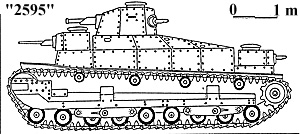(this article was translated by Craig Martelle from the Russian magazine Armor Collection, which detailed a number of obscure Japanese tanks used during WWII)
By 1927, the arsenal in Osaka built an experimental twin-turreted, 18-ton tank – Number 1 ("Chi-I, Medium First") with a 57mm gun, two machineguns, and a 140hp engine. In 1931, the same arsenal built an 18-ton, triple-turreted "91" with experimental guns and two machineguns in the forward turrets and a single machinegun in the turret directly behind the engine compartment.
In the main turret was a 70mm gun (18.2 caliber, each round weighed 4.6kg, muzzle velocity up to 300m/s) and a 6.5mm machinegun. Crew consisted of 5. The tank initially used a 6-cylinder carburatedBMW engine rated at 224hp (at 1200rpms) which drove the tank up to 25km/hr for a max range of 160km. Road wheels, drive sprocket, return rollers are as shown. The tank could climb a 30 degree slope and cross a 3-meter wide trench.
In 1934, R&D continued and the 3-turreted "95" was built with the 70mm gun, viewing ports with pop-off covers and side hatches. A main feature of this tank was the air defense machine gun (ed note – prob from main turret). In 1941-1943, a total of 13 "Kho-Ro" were built (ed note – refers to 2591). They participated in the battles on Luzon in December of 1944.
The anti-tank SAU Type 1 ("Kho-Ni") was armed with a 75mm Type 90 cannon. A 5.9kg round fired at a velocity of 680m/s was able to penetrate, at 450m, a target with armor to 100mm. A target 900m away – it could penetrate up to 75mm. The main gun could be elevated to 25 degrees and depressed –5 degrees and could engage targets only 20 degrees off center without turning the whole tank. The entire tank was armored with 16mm thick panels. The "2595" had a spot for an anti-aircraft machinegun. The "Kho-Ni" (ed note – refers to 2595) was produced from 1942 to 1945 – a total of 125 copies were built. The "Kho-Ni" also saw action on Luzon.
A self-propelled howitzer "Type 1" ("Kho-Ni II") provided its own fire support. The 105mm howitzer "Type 99" was only able to fire up to 10 degrees off center. Because of the immense length of the barrel, it could only be elevated to 22 degrees. Minimum range was 454m and max range was 10,800m. Each round weighed 16kg and had a muzzle velocity of 550m/s. Eight rounds per minute could be fired.
On the same chassis was even tried a 75mm anti-tank gun called the "Kho-Ni III". It had a fully enclosed, seven-sided hull with extra armor and hatches on top. There was an escape hatch in the rear. The self-propelled anti-tank cannon was similar to the "Chi-Nu" and was considered a Medium Tank. The anti-tank version had a radio set with twin antennas from the hull. Few SAU (anti-tank variants) were built in 1944: the self-propelled 75mm anti-tank "Ku-Sae" on the chassis "Chi-Khe"; 120mm self-propelled howitzer "Kha-No" on the light chassis "Kha-Go". In 1945, on the "Cha-Kha" chassis the experimental 155mm cannon "Type 5, Kho-Chi" was used.

Back to Rebel Yell No. 5 Table of Contents
Back to Rebel Yell List of Issues
Back to Master Magazine List
© Copyright 1997 by HMGS South
This article appears in MagWeb (Magazine Web) on the Internet World Wide Web.
Other military history articles and gaming articles are available at http://www.magweb.com